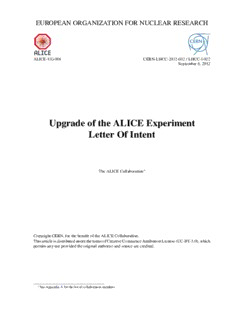
The ALICE ITS upgrade - CERN Document Server PDF
Preview The ALICE ITS upgrade - CERN Document Server
EUROPEAN ORGANIZATION FOR NUCLEAR RESEARCH ALICE-UG-001 CERN-LHCC-2012-012/LHCC-I-022 September8,2012 Upgrade of the ALICE Experiment Letter Of Intent TheALICECollaboration ∗ CopyrightCERN,forthebenefitoftheALICECollaboration. ThisarticleisdistributedunderthetermsofCreativeCommenceAttributionLicense(CC-BY-3.0),which permitsanyuseprovidedtheoriginalauthor(s)andsourcearecredited. SeeAppendixAforthelistofcollaborationmembers ∗ Contents 1 Introduction 1 1.1 StudyofQuark–GluonPlasma . . . . . . . . . . . . . . . . . . . . . . . . . . . . . . . 1 1.2 ProposedPhysicsProgramme. . . . . . . . . . . . . . . . . . . . . . . . . . . . . . . . 3 1.2.1 Heavy-FlavourProduction . . . . . . . . . . . . . . . . . . . . . . . . . . . . . 4 1.2.2 ProductionofQuarkonia . . . . . . . . . . . . . . . . . . . . . . . . . . . . . . 5 1.2.3 Low-MassDileptons . . . . . . . . . . . . . . . . . . . . . . . . . . . . . . . . 6 1.2.4 JetMeasurements . . . . . . . . . . . . . . . . . . . . . . . . . . . . . . . . . . 7 1.2.5 HeavyNuclearStates . . . . . . . . . . . . . . . . . . . . . . . . . . . . . . . . 8 1.2.6 ComparisonofPhysicsReach . . . . . . . . . . . . . . . . . . . . . . . . . . . 8 1.2.7 ComparisonwithOtherLHCExperiments. . . . . . . . . . . . . . . . . . . . . 9 1.3 ALICEDetectorUpgrade . . . . . . . . . . . . . . . . . . . . . . . . . . . . . . . . . . 11 1.4 Runningscenario . . . . . . . . . . . . . . . . . . . . . . . . . . . . . . . . . . . . . . 12 2 PhysicsMotivation 15 2.1 HeavyFlavour . . . . . . . . . . . . . . . . . . . . . . . . . . . . . . . . . . . . . . . . 15 2.1.1 Heavy-flavourThermalization,Coalescence,andPossibleThermalProduction . 16 2.1.2 Heavy-flavourEnergyLoss . . . . . . . . . . . . . . . . . . . . . . . . . . . . . 36 2.1.3 Proton–ProtonRunningRequirementsforHeavy-flavourReferenceData . . . . 39 2.2 Quarkonia . . . . . . . . . . . . . . . . . . . . . . . . . . . . . . . . . . . . . . . . . . 42 2.2.1 Motivation . . . . . . . . . . . . . . . . . . . . . . . . . . . . . . . . . . . . . 42 2.2.2 InputsforSimulations . . . . . . . . . . . . . . . . . . . . . . . . . . . . . . . 48 2.2.3 J/ψ YieldandtheNuclearModificationFactor . . . . . . . . . . . . . . . . . . 48 2.2.4 J/ψ EllipticFlow . . . . . . . . . . . . . . . . . . . . . . . . . . . . . . . . . . 48 2.2.5 J/ψ Polarization . . . . . . . . . . . . . . . . . . . . . . . . . . . . . . . . . . 49 2.2.6 ElectromagneticJ/ψ Production . . . . . . . . . . . . . . . . . . . . . . . . . . 51 2.2.7 ψ(2S)Measurement . . . . . . . . . . . . . . . . . . . . . . . . . . . . . . . . 51 i ii TheALICECollaboration 2.3 Low-MassDileptons . . . . . . . . . . . . . . . . . . . . . . . . . . . . . . . . . . . . 54 2.3.1 ScientificObjectives . . . . . . . . . . . . . . . . . . . . . . . . . . . . . . . . 54 2.3.2 ExperimentalChallenges . . . . . . . . . . . . . . . . . . . . . . . . . . . . . . 58 2.3.3 PhysicsPerformance . . . . . . . . . . . . . . . . . . . . . . . . . . . . . . . . 59 2.4 Jets . . . . . . . . . . . . . . . . . . . . . . . . . . . . . . . . . . . . . . . . . . . . . 68 2.4.1 JetMeasurementsinALICE . . . . . . . . . . . . . . . . . . . . . . . . . . . . 71 2.4.2 JetStructureModifications . . . . . . . . . . . . . . . . . . . . . . . . . . . . . 73 2.4.3 Photon–JetMeasurements . . . . . . . . . . . . . . . . . . . . . . . . . . . . . 74 2.4.4 HeavyFlavourJets . . . . . . . . . . . . . . . . . . . . . . . . . . . . . . . . . 78 2.4.5 ReferenceData . . . . . . . . . . . . . . . . . . . . . . . . . . . . . . . . . . . 80 2.5 HeavyNuclearStates . . . . . . . . . . . . . . . . . . . . . . . . . . . . . . . . . . . . 80 3 DetectorsandReadoutElectronics 85 3.1 Introduction . . . . . . . . . . . . . . . . . . . . . . . . . . . . . . . . . . . . . . . . . 85 3.2 Beampipe . . . . . . . . . . . . . . . . . . . . . . . . . . . . . . . . . . . . . . . . . . 86 3.3 ITSUpgrade. . . . . . . . . . . . . . . . . . . . . . . . . . . . . . . . . . . . . . . . . 87 3.3.1 CurrentITSPerformanceandLimitations . . . . . . . . . . . . . . . . . . . . . 87 3.3.2 ITSUpgrade . . . . . . . . . . . . . . . . . . . . . . . . . . . . . . . . . . . . 90 3.3.3 TechnicalImplementation . . . . . . . . . . . . . . . . . . . . . . . . . . . . . 94 3.4 TPCUpgrade . . . . . . . . . . . . . . . . . . . . . . . . . . . . . . . . . . . . . . . . 95 3.4.1 StatusandLimitationsofthePresentTPC . . . . . . . . . . . . . . . . . . . . . 95 3.4.2 UpgradeConcept . . . . . . . . . . . . . . . . . . . . . . . . . . . . . . . . . . 96 3.4.3 ExpectedPerformanceoftheUpgradedTPC . . . . . . . . . . . . . . . . . . . 96 3.4.4 TechnicalImplementation . . . . . . . . . . . . . . . . . . . . . . . . . . . . . 100 3.4.5 R&D . . . . . . . . . . . . . . . . . . . . . . . . . . . . . . . . . . . . . . . . 101 3.4.6 PrototypeTest . . . . . . . . . . . . . . . . . . . . . . . . . . . . . . . . . . . 102 3.4.7 Front-EndandReadoutElectronics . . . . . . . . . . . . . . . . . . . . . . . . 102 3.5 UpgradeofTOFReadoutElectronics . . . . . . . . . . . . . . . . . . . . . . . . . . . 104 3.6 UpgradeofTRDReadoutElectronics . . . . . . . . . . . . . . . . . . . . . . . . . . . 105 3.7 MuonSpectrometerUpgrade . . . . . . . . . . . . . . . . . . . . . . . . . . . . . . . . 107 3.7.1 MuonTriggerUpgrade . . . . . . . . . . . . . . . . . . . . . . . . . . . . . . . 107 3.7.2 MuonTrackingUpgrade . . . . . . . . . . . . . . . . . . . . . . . . . . . . . . 109 3.8 OtherUpgradeItems . . . . . . . . . . . . . . . . . . . . . . . . . . . . . . . . . . . . 110 ALICEUpgradeLOI iii 4 DataCollectionandProcessing 113 4.1 Introduction . . . . . . . . . . . . . . . . . . . . . . . . . . . . . . . . . . . . . . . . . 113 4.2 Requirements . . . . . . . . . . . . . . . . . . . . . . . . . . . . . . . . . . . . . . . . 113 4.2.1 EventRates,EventSizesandDataThroughput . . . . . . . . . . . . . . . . . . 114 4.2.2 OnlineDataReduction . . . . . . . . . . . . . . . . . . . . . . . . . . . . . . . 114 4.2.3 OnlineDataProcessingRequirements . . . . . . . . . . . . . . . . . . . . . . . 116 4.2.4 OfflineDataProcessingandStorageRequirements . . . . . . . . . . . . . . . . 117 4.3 Architecture . . . . . . . . . . . . . . . . . . . . . . . . . . . . . . . . . . . . . . . . . 118 4.3.1 FastTriggerProcessor . . . . . . . . . . . . . . . . . . . . . . . . . . . . . . . 118 4.3.2 Dataflow . . . . . . . . . . . . . . . . . . . . . . . . . . . . . . . . . . . . . . 118 4.3.3 FarmLayout . . . . . . . . . . . . . . . . . . . . . . . . . . . . . . . . . . . . 120 4.3.4 PlatformIndependence . . . . . . . . . . . . . . . . . . . . . . . . . . . . . . . 121 4.3.5 DetectorControlSystem . . . . . . . . . . . . . . . . . . . . . . . . . . . . . . 121 4.3.6 Infrastructure . . . . . . . . . . . . . . . . . . . . . . . . . . . . . . . . . . . . 122 4.4 Research,PrototypingandDevelopment . . . . . . . . . . . . . . . . . . . . . . . . . . 122 4.4.1 DDLandRORC . . . . . . . . . . . . . . . . . . . . . . . . . . . . . . . . . . 122 4.4.2 High-LevelProgrammingofFPGAs . . . . . . . . . . . . . . . . . . . . . . . . 123 4.4.3 FLPandEPN . . . . . . . . . . . . . . . . . . . . . . . . . . . . . . . . . . . . 124 4.4.4 FarmNetwork . . . . . . . . . . . . . . . . . . . . . . . . . . . . . . . . . . . 125 4.4.5 ReconstructionSoftware . . . . . . . . . . . . . . . . . . . . . . . . . . . . . . 127 4.4.6 ParallelHLTReconstructiononGPUandCPU . . . . . . . . . . . . . . . . . . 131 4.4.7 AnalysisofCurrentAliRootPerformance . . . . . . . . . . . . . . . . . . . . . 132 4.4.8 PlansfortheDevelopmentofParallelAliRoot. . . . . . . . . . . . . . . . . . . 133 5 Schedule,CostEstimateandOrganization 135 5.1 Schedule . . . . . . . . . . . . . . . . . . . . . . . . . . . . . . . . . . . . . . . . . . . 135 5.2 CostEstimate . . . . . . . . . . . . . . . . . . . . . . . . . . . . . . . . . . . . . . . . 139 5.3 Organization. . . . . . . . . . . . . . . . . . . . . . . . . . . . . . . . . . . . . . . . . 146 ListofFigures 155 ListofTables 164 References 167 A TheALICECollaboration . . . . . . . . . . . . . . . . . . . . . . . . . . . . . . . . . 177 iv TheALICECollaboration Chapter 1 Introduction QuantumChromoDynamics(QCD)iswell-establishedasthegaugetheoryofstronginteractions. How- ever,severalofitsfundamentalaspectsarenotwell-understoodatpresent. Thereremainimportantopen questionsabouttheparton–hadrontransitionandthenatureofconfinement,andaboutthenatureofQCD matter at high temperature. A much deeper insight into the mechanisms underlying chiral-symmetry breakingandtheoriginoflight-quarkmassisnecessary. This Letter of Intent (LoI) presents the plans of the ALICE (A Large Ion Collider Experiment [1]) col- laborationtoextenditsphysicsprogramme,inordertofullyexploitthescientificpotentialoftheLarge Hadron Collider (LHC) for fundamental studies of QCD, with the main emphasis on heavy-ion colli- sions. TheproposedenhancementoftheALICEdetectorperformancewillenabledetailedandquantita- tivecharacterizationofthehighdensity, hightemperaturephaseofstronglyinteractingmatter, together withtheexplorationofnewphenomenainQCD.Inthefollowingweoutlinethephysicsmotivationfor running the LHC with heavy ions at high luminosities and summarize the performance gains expected withtheupgradedALICEdetector. Withtheproposedtimelineofinitiatinghigh-rateoperationafterthe 2018LongShutdown(LS2),theobjectivesofourupgradeplanswillbeachievedbycollectingdatainto themid-2020’s. 1.1 StudyofQuark–GluonPlasma Strongly-interacting matter at very high temperature and density is expected to exist in a state called the Quark–Gluon Plasma (QGP), in which quark and gluon degrees of freedom are liberated, and with properties very different from the hadronic matter we ordinarily find around us. Such conditions of high temperature and density prevailed in the early Universe, a few microseconds after its formation. However, the cosmological QGP epoch is effectively shielded from astronomical observations by the subsequent evolution of the Universe, and the only means to study this fundamental state of matter is via the collision of heavy nuclei in the laboratory. In heavy-ion collisions at ultra-relativistic energies, nuclearmatterisheatedandbroughttovaluesoftemperatureanddensitywellbeyondthoserequiredfor the creation of QGP, and the same kind of medium that filled the very early Universe is generated for a fleetinginstant. To reach the QGP state, matter has to undergo a QCD phase transition, and that reflects breaking of a fundamental symmetry in the theory. Below the corresponding critical temperature, matter is best described in terms of hadronic degrees of freedom, with quarks and gluons confined in colour-neutral objects. As the temperature rises the hadrons melt (deconfinement phase transition) and quarks and gluonsarenolongerboundintohadrons. Thedeconfinementphasetransitioniscausedbythebreakingof theZ -symmetry(exactsymmetryinthelimitofpure-gaugeQCD)athightemperature,andisillustrated 3 1 2 TheALICECollaboration inFigure2.46(left)byamarkedchangeofthecorrespondingorderparameter,theexpectationvalueof Polyakovloop. A second phase transition is connected with the generation of hadronic mass, as a consequence of the presence of a quark–antiquark condensate in the vacuum at low temperature. At high temperatures, the vacuumcondensatedecreases,andthemassesofquarksdroptotheirbarevaluesduringthechiralphase transition. This can be seen in Figure 2.46 (right): the expectation value for the density of vacuum quark–antiquark condensate, i.e. the order parameter of the chiral transition, exhibits a sudden drop in thevicinityofthecriticaltemperature. Theunderlyingreasonforthisphasetransitionistherestoration oftheapproximatechiralsymmetry(exactsymmetryinthelimitofzerobarequarkmasses)oftheQCD Lagrangian. Lattice-QCDcalculationspredictthatthetransitionbetweentheQGPandhadronicmatteratzerobaryo- chemical potential is not a sharp phase transition, but rather a smooth cross-over occurring over a wide temperature range (see Figure 2.46). Recent calculations also suggest that the two phase transitions may occur at different critical temperatures [2]. Lattice QCD further predicts that even at several times the transition temperature, the energy density is still about 15% below that expected for the Stefan– Boltzmannlawforanidealgasofnon-interactingquarksandgluons,withveryslowconvergencetothis limit. This indicates that the effective degrees of freedom in a QGP at finite temperature are not bare quarksandgluons,butrathermorecomplexformationswhosenaturehasnotyetbeenunderstood. The crucial question of effective degrees of freedom in the QGP is also addressed experimentally, and is an area ofintenseactivity inthe fieldat present. However, it remains aprofound challengefor experiment andtheory,andmayhaveadeepconnectiontootherareasofphysicsandcosmology. The experimental demonstration of these phase transitions, the verification of the lattice QCD predic- tions reflecting the fundamental symmetries of the theory, and a detailed investigation of the properties of strongly interacting matter at high temperature, are the principal aims of the ALICE scientific pro- gramme. Precise determination of the QGP properties, including critical temperature, degrees of free- dom,speedofsound,and,ingeneral,transportcoefficientsandequationofstate,istheultimategoalin the field. This would go a long way towards a better understanding of QCD as a genuine multi-particle theory,sheddinglightonthecomplexissuesofdeconfinementandchiral-symmetryrestoration. ThetheoreticalexpectationformanyyearswasthattheQGPathightemperatureisaweakly-interacting gas of quarks and gluons, with the constituents traveling long distances between interactions, relative to the size of a proton. Heavy-ion experiments indicate instead fundamentally different and surprising behaviour of the created matter: the formation of a strongly-coupled plasma with very short mean free path, which exhibits a high degree of collectivity and flows, and which absorbs a significant fraction of high-energy partons propagating through it. Over time, the image of the QGP as an almost-perfect, inviscid liquid emerged from the experimental investigation at both, CERN SPS and BNL RHIC. With thefirsttwoyearsofLHCrunning,theALICEcollaborationhasconfirmedthisbasicpicture,observing thecreationofhothadronicmatteratunprecedentedvaluesoftemperatures,densitiesandvolumes. The firstresultsextendedtheprecisionandkinematicreachofallsignificantprobesoftheQGPthathadbeen measured over the past decade, and new and intriguing phenomena were observed with charm mesons andcharmonia. The observation that the QGP is a near-perfect liquid is based on measurements of inclusive spectra (radialflow)andazimuthalanisotropyofparticleproduction(ellipticflow)foridentifiedhadronsatsoft transverse momenta (p ), up to about 3 GeV/c. This is further confirmed by comparison to model cal- T culationsbasedonviscousrelativistichydrodynamics. Hydrodynamicsisageneralapproachtofluiddy- namics,describingthelong-wavelengthbehaviourofacomplexsysteminquasi-equilibrium,andserves as a powerful tool to determine the QGP properties. The good agreement of hydrodynamic calculation with ALICE and other experiments flow measurements provides strong evidence for the formation of a ALICEUpgradeLOI 3 quasi-equilibratedQGPinheavy-ioncollisionsatLHCenergies. Theverylowratioofshear-viscosityto entropy-densityoftheQGP,inferredfromthecomparisonofmodelcalculationsandexperimentalmea- surements, demonstrates very short mean free path inside this medium composed of strongly-coupled quasi-particlemodes,whoseoriginisthesubjectoffurtherexperimentalstudy. 1.2 ProposedPhysicsProgramme TheLHCprovidestheoptimalexperimentalconditionstostudytheQGP,duetothefollowing: – the net baryon density in the central (mid-rapidity) region is very small, corresponding to the conditionsoftheearlyUniverse; – theinitialtemperatureandenergydensityarethehighestachievableinthelaboratory; – thelargecollisionenergyensuresanabundanceofperturbativelycalculablehardQCDprocesses. Thestudyofthestrongly-interactingstateofmatterinthesecondgenerationofLHCheavy-ionstudies followingLS2willfocusonrareprobes,andthestudyoftheircouplingwiththemediumandhadroniza- tion processes. These include heavy-flavour particles, quarkonium states, real and virtual photons, jets andtheircorrelationswithotherprobes. Thecrosssectionsofalltheseprocessesaresignificantlylarger at LHC than at previous accelerators. In addition, the interaction with the medium of heavy-flavour probes is better controlled theoretically than the propagation of light partons. All these investigations should involve soft momentum scales, and thus benefit from the ALICE detector strengths: excellent tracking performance in high-multiplicity environment and particle identification over a large momen- tumrange. Inmostofthesestudies,theazimuthalanisotropyofdifferentprobeswillbemeasured. Major highlightsoftheproposedprogrammefocusonthefollowingphysicsquestions: – Study of the thermalization of partons in the QGP, with focus on the massive charm and beauty quarks. Heavy-quarkazimuthal-flowanisotropyisespeciallysensitivetothepartonicequationof state. Ultimately, heavy quarks might fully equilibrate and become part of the strongly-coupled medium. – Study of the low-momentum quarkonium dissociation and, possibly, regeneration pattern, as a probeofdeconfinement,andanevaluationofthemediumtemperature. – Study of the production of thermal photons and low-mass dileptons emitted by the QGP. This should allow to assess the initial temperature and the equation of state of the medium, as well as toshedlightonthechiralnatureofthephasetransition. – Studyofthein-mediumpartonenergy-lossmechanismthatprovidesbothatestinggroundforthe multi-particle aspects of QCD and a probe of the QGP density. The relevant observables are: jet structure, jet–jetandphoton–jetcorrelations, andjetcorrelationswithhigh-momentumidentified hadrons and heavy-flavour particle production in jets. In particular, it is crucial to characterize the dependencies of energy loss on the parton colour-charge, mass, and energy, as well as on the densityofthemedium. – Search for heavy nuclear states such as light multi-Λ hyper-nuclei 5H, bound states of (ΛΛ) ΛΛ or the H dibaryon, (Λn) bound state, as well as bound states involving multi-strange baryons; a systematicstudyoflightnucleiandanti-nucleiproduction. Belowweoutlinethebasicphysicsmotivationforthesemeasurements;thedetailsandthecorresponding performancestudiesaredescribedinChapter2. 4 TheALICECollaboration 1.2.1 Heavy-FlavourProduction High-precisionmeasurementsofcharmandbeautyproductioninheavy-ioncollisionsattheLHCisone oftheprincipalphysicsmotivationsfortheupgradeoftheALICEdetectorandthehigh-luminosityrun- ningoftheexperiment. Theenvisagedmeasurementsofopenheavy-flavourproductionwillmakepossi- bletopreciselydetermineimportantparametersofthestronglyinteractingmatterthatarenotaccessible withthepresentexperimentalsetup,seeSection2.1fordetails. Twotopicsthatneedhigh-precisionand high-statisticsmeasurementsareproposedtostudy: – thermalizationofheavyquarksinthemedium,bydeterminationofthebaryon-to-mesonratiofor charmandforbeautyparticles,theazimuthal-flowanisotropyforcharmmesonsandbaryonsand beautyparticles,andthepossiblein-mediumthermalproductionofcharmquarks; – parton mass and colour-charge dependence of in-medium energy loss, by measuring the p - T dependencies of the nuclear modification factors separately for D and B mesons, and comparing themwiththoseforlight-flavourparticles. Thesetwotopicsarecloselyconnected: thein-mediumheavy-quarkenergylosslowersthemomentaof heavy quarks, they may thermalize in the system, and thus participate in the collective flow dynamics. Thesimultaneousobservationofthetwophenomenaopensthepossibilityfordeterminationoftheheavy- flavour transport coefficients. Heavy-flavour production plays a special role in heavy-ion physics: it provides a calibrated probe (input p spectra calculable from perturbative QCD), and, in addition, this T probe is well-tagged (identified), from production till observation, which enables a unique access to its interactionsintheQGP,alsointhelow-andintermediate-p regime. T The ALICE collaboration already presented the first results on D-meson production in heavy-ion colli- sions. To address the physics questions mentioned above, these measurements have to be extended to a lower p ,includecharmbaryons(possiblyalsocharm–strangebaryons)andbeautyparticles. Thecapa- T bilityofstudyingyieldsandspectraofparticlescontainingheavyquarksisgivenbytheperformanceof secondary-vertexisolationclosetotheprimary-interactionvertex. Charmproductionismeasuredbythe reconstruction of exclusive hadronic decays using topological selection of a secondary vertex. Particle identificationforchargedhadronsisneededtoreducetheverylargebackgroundsinheavy-ioncollisions, especially at low transverse momentum. In addition, charm and beauty can be tagged in semi-leptonic decays, detecting electrons and muons. Therefore, the excellent particle-identification capabilities of the ALICE detector have to be preserved. However, important physics topics, such as the study of heavy-flavourbaryonsorofopenheavy-flavourhadronswithmorethanoneheavyquark,arebeyondthe capabilityofthepresentdetector. Preliminarymeasurementsoftheelliptic-flowcoefficientv (theamplitudeofsecondorderharmonicof 2 theazimuthaldistribution)fordifferentDmesonsin30–50%centralPb-Pbcollisionswereobtainedby the ALICE experiment; the result is very intriguing, because it suggests that D mesons in the p range T 2–6GeV/cmayindeedtakepartinthecollectiveflow. Modelstakingintoaccountheavy-quarktransport inthemedium, withvariousimplementationsofthequark–mediuminteraction, predictalargev forD 2 mesons at low transverse momenta that should become accessible with the upgraded ALICE detector. Thelow-p Bmesonsv ,notinthereachofpresentexperiments,ispredictedtobesubstantiallysmaller T 2 than that for D mesons. Such difference in the azimuthal anisotropy at intermediate p is inherent to T theQCDinteractionmechanisms,andwouldthusserveasanimportanttestofourunderstandingofthe natureofmatterformedinheavy-ioncollisions. The study of heavy-flavour energy loss has a particular interest, because gluon radiation from heavy quarksatsmallanglesispredictedtobesuppressed,incomparisontothecaseoflightpartons. Moreover, at LHC energies, high-p light-flavour hadrons are dominantly produced in gluon fragmentation, and T
Description:The list of books you might like

The Strength In Our Scars

What Happened to You?

Shatter Me Complete Collection (Shatter Me; Destroy Me; Unravel Me; Fracture Me; Ignite Me)

The 48 Laws of Power

Your Turn Answer Key - Houghton Mifflin Harcourt
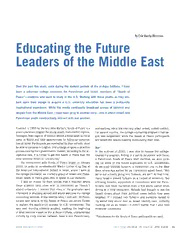
ERIC EJ783937: Educating the Future Leaders of the Middle East

The Window-Gazer by Isabel Ecclestone Mackay

Beginning C for Arduino: Learn C programming for the Arduino
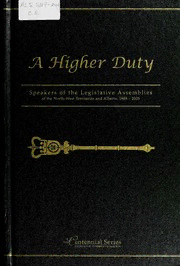
Centennial series (Legislative Assembly of Alberta), 1869-2005: A higher duty
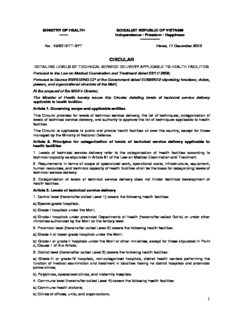
BỘ Y TẾ
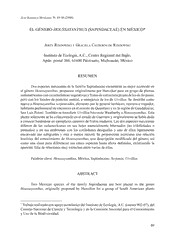
El género Houssayanthus (Sapindaceae) en México
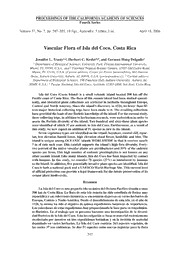
Vascular Flora of Isla del Coco, Costa Rica

C-uppsats_30 maj

Calixarene Complexes with Transition Metal, Lanthanide and Actinide Ions

Amazon Cognito - 개발자 안내서
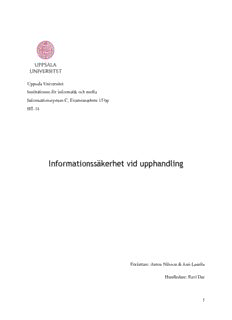
C uppsats Joni & Anton rev.2 .docx
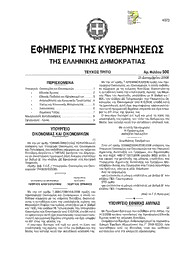
Greek Government Gazette: Part 3, 2006 no. 500
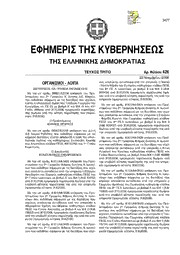
Greek Government Gazette: Part 3, 2006 no. 426

Called The Black Pope by many of his followers, Anton
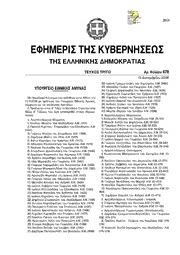
Greek Government Gazette: Part 3, 2006 no. 478
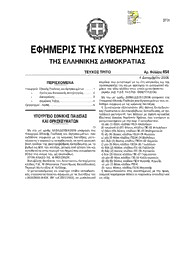
Greek Government Gazette: Part 3, 2006 no. 454
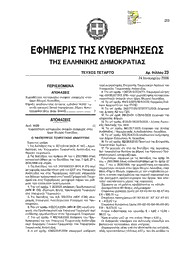
Greek Government Gazette: Part 4, 2006 no. 23
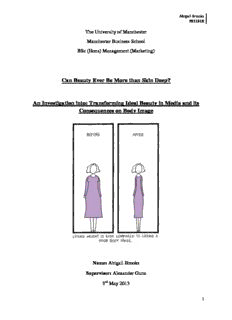
Can Beauty Ever Be More than Skin Deep?

